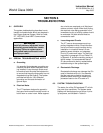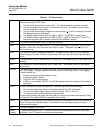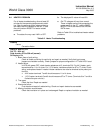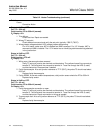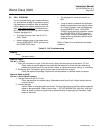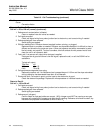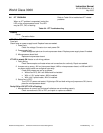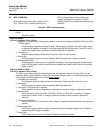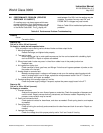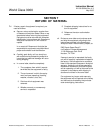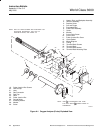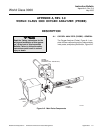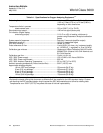
Instruction Manual
IB-106-300NH Rev. 4.3
May 2005
Rosemount Analytical Inc. A Division of Emerson Process Management Troubleshooting 6-9
World Class 3000
6-8 PERFORMANCE PROBLEM (PROCESS
RESPONSE IS SUSPECT)
O
2
readings may not always agree with known
process conditions. Such a discrepancy can be
the first sign of a problem either in the process
or the World Class 3000. The O
2
display will
read between 0 to 99%, but the reading may be
unstable. The status line may read OK, and
PROBE DATA voltages may read normal.
Refer to Table 6-6 to troubleshoot performance
problems.
Table 6-6. Performance Problem Troubleshooting
Problem
Cause
Corrective Action
Status is OK.
Cell mV is -20 to 120 mV (normal).
O
2
display is stable but not expected value.
Such a condition occurs during various kinds of leaks and data output faults.
1. Mounting flange leak.
Reseal the flange, and tighten bolts properly.
2. Test gas line leak.
Since the test gas line is under positive pressure, the line can be tested with a bubbling liquid
such as SNOOP
TM
. Repair or replace as needed.
3. Silicon hose break. Leaks may occur in the silicon rubber hose in the probe junction box.
Replace hose.
4. Air ingress from leaky duct.
Check condition of duct, gas lines, and fittings. If duct has air ingress upstream of probe, re-site
the probe or fix the leak.
5. Analog output or recorder fault.
Measure analog output in voltage or milliamps as set up on the analog output board and soft-
ware. If analog output is not in range, replace the microprocessor board in the IFT. Check re-
corder function, and repair as needed.
6. Random spiking of the analog output to 0 mA dc.
Check the power supply voltage. If suspect, replace the power supply board in the IFT.
Status is OK.
Cell mV is -20 to 120 mV (normal).
O
2
display is unstable.
1. Process variations.
Analyze the process for even flows of gases or materials. Check the operation of dampers and
control valves. Repair process devices, procedures, and flows as needed. Depending on the
process, some variation may be normal.
2. Pad to cell connection fault.
Check pad and contact for cleanliness, and clean as needed. Check spring tension, and replace
as needed.
3. Grounding fault.
Check all wiring for continuity and connections for cleanliness and lack of corrosion. Repair as
needed.
4. Improper line voltage.
Check line voltage circuit for proper polarity and/or "hot" and "neutral" circuitry.



